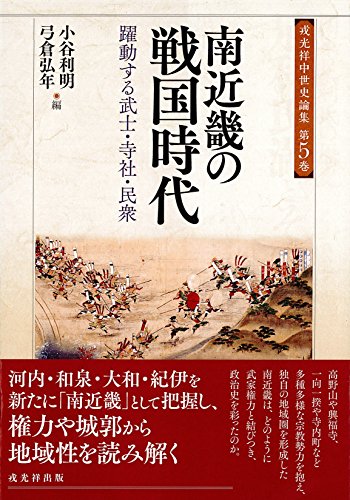- 著者
- 小谷 利明
- 出版者
- 日本史研究会
- 雑誌
- 日本史研究 (ISSN:03868850)
- 巻号頁・発行日
- no.510, pp.55-79, 2005-02
1 0 0 0 南近畿の戦国時代 : 躍動する武士・寺社・民衆
- 著者
- 小谷利明 弓倉弘年編
- 出版者
- 戎光祥出版
- 巻号頁・発行日
- 2017
1 0 0 0 IR 戦国期の河内国守護と一向一揆勢力 宗教と政治
- 著者
- 小谷 利明
- 出版者
- 佛教大学総合研究所
- 雑誌
- 佛教大学総合研究所紀要 (ISSN:13405942)
- 巻号頁・発行日
- vol.1998, no.1, pp.153-201, 1998-03-14
In order to investigate some characteristics of power structure in Kinki area in Sengoku period I analyzed mainly Kawachi province. The significance of examining one clan as a measure was in order to scrutinize the former recognition of Kinki area in Sengoku period. That is to say, the theory of seeing Kinki area as a whole domain ruled by Hosokawa KyochO family made the discussion of the characteristics of each county in Kinki area difficult, as well as hindering deeper research into the relationship between the power of Daimyo (lord) and that of Ikko Ikki (Ikko Uprising). Here, I presented two different types of Ryoshu existent in the power structures used by Hatakeyama, a military governor in Sengoku period, and discussed the changes taking place within them from the beginning to the middle of 16th century. One type was a bureaucratic type of lord (kanryo-gata sengokuryoshu) , a magistrate possessing the privilege to issue Hanbutsu and sharing a part of the military lord's power. Another type was a locally powerful lord (chi'ikikenryoku-gata sengoku ryoshu) , supported by warriors, having a strong 1 military power of his own. The foundation of power in 16th century was related to the birth of a new region. Previously, the domination of regions by military lords was considered to exist at county-level, but with the expansion of regions, the area had become much larger than a county. Regional codes (kokuho) were promulgated in those wide areas and a group of them was united into two parts called jogun (upper county) and Gegun (lower county). Chi'ikikenryoku-gata sengoku ryoshu gained military power in these areas. Meanwhile, development of the influence of Ikko Ikki had some connection to those new areas. Villages related to Honganji were formed on a river bank naturally made by Y odo and Yamato rivers, and this bank was maintained by the integration of Shugo (military lord), Kokujin (local lords) and Ikko sectarians. A military lord was deeply involved in maintenance of this bank in the 16th century. The Tenbun Ikko Ikki that took place in the middle of 16th century was a serious battle between military lords and Ikko sectarians. The peace negotiations phazed into two stages. First was the negotiation between each Shugo and Ryoshu and second was Shugo and Ryoshu together negotiating with the peasants. As a result the power of S/zugo overcame the power of all Ryoshu as the former guaranteed Buji, Safety. Kokuho, regional codes at this time existed basically in order to protect peasants and to prevent private conflicts, and corresponded to Buji provided by Shugo. jinaimachi in Kawachi Province was founded on the grounds of Buji by Shugo and was in practice supported by Chi' ikikenryoku-gata Sengoku Ryoshu. Osakanami established in the Eiroku era (1558-1569) as a movement of obtaining the privilege of Jinai is considered to have developed since Honganji had become Monseki and the Jinaimachi were officially authorized.
